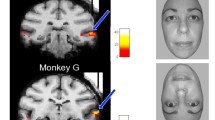Conclusions
-
1.
The “classification” of relatively simple stimuli in the form of picture contours and planar geometric figures differing in color, shape, and size was accessible to animals after extirpation of the proreate gyrus.
-
2.
The possibility of transferring previous learning experience (generalization with respect to quality) to new stimuli with the same alternative trait (generalization with respect to quantity) and generalization with elements of abstraction from concrete objects suffered sharply during frontal pathology in cats.
-
3.
The frontal cortex is the most important component in the mechanisms of mental processes associated with a transition from the systematization of specific information to processes of formation of broad concepts requiring a high degree of abstraction.
Similar content being viewed by others
Literature cited
O. S. Adrianov, Principles of Organization of the Integrative Activity of the Brain [in Russian], Meditsina, Moscow (1976).
O. S. Adrianov and L. N. Moloakina, “Influence of lobectomy on the ability of cats to solve an extrapolational task,” Zh. Vyssh. Nervn. Deyat.,19, No. 4, 593 (1969).
A. S. Batuev, Evolution of Frontal Lobes and the Integrative Activity of the Brain [in Russian], Meditsina, Leningrad (1973).
B. I. Belyi, “Psychopathology of focal injury of frontal lobes in light of the functional asymmetry of the brain,” in: Functional Asymmetry and Human Adaptation [in Russian], Moscow (1976), p. 205.
A. D. Vladimirov and A. R. Luriya, “Disruption of visual perception after injury to the poles of the frontal lobes of the brain,” in: Problems in Neuropsychology [in Russian], Nauka, Moscow (1977), p. 255.
M. M. Kol'tsova, Generalization as a Brain Function [in Russian], Nauka, Moscow (1967).
A. E. Koroleva and N. M. Foya, “Influence of removal of frontal brain segments on the development and occurrence of the conditioned response to a relative sign of magnitude in dogs,” Fiziol. Zh.,20, No. 2, 154 (1974) (Ukrainian).
G. N. Kryzhanovskii, “Determinant structures in nervous-system pathology,” in: Generator Mechanism of Neuropathological Syndrome [in Russian], Meditsina, Moscow (1980).
A. R. Luriya, Bases of Neuropsychology [in Russian], Mosk. Gos. Univ., Moscow (1973).
P. Milner, Physiological Psychology, Holt, Rinehart and Winston (1970).
E. N. Mukhin, “Some new experimental approaches to the analysis of complex forms of behavior,” Zh. Vyssh. Nervn. Deyat.,30, No. 6, 1181 (1980).
Pavlovian Environments [in Russian], Vol. 2, Izd. Akad. Nauk SSSR, Leningrad (1949), pp. 579–580.
Pavlovian Environments [in Russian], Vol. 3, Izd. Akad. Nauk SSSR, Leningrad (1949), pp. 7–8.
P. V. Simonov, Natural-Science Bases of Individuality [in Russian], Zh. Vyssh. Deyat.,31, No. 1, 12 (1981).
N. F. Suvorov, Striatal System and Behavior [in Russian], Nauka, Leningrad (1980).
Yu. V. Uryvaev, “The frontal cortex and goal-directed behavior,” in: Topical Questions in Contemporary Physiology [in Russian], Nauka, Moscow (1976), p. 52.
N. A. Shustin, Systems Activity of the Brain [in Russian], Nauka, Moscow (1976), p. 52.
H. Bonnet, “Les formes atypiques d'excitation de l'humeur ou les excitations et les manies 'masquées',” Lyon Méd.,241, No. 1, 25 (1979).
R. Hannon and M. Kamback, “Effects of dorsolateral frontal lesions on responsiveness to various stimulus parameters in the pigtail monkey,” Exp. Neurol.,37, No. 1, 1 (1972).
L. V. Horst, “Form and function of the frontal brain,” Psychiatr. Neurol. Neurochirurg.,66, No. 4–5, 326 (1963).
E. M. Ockleford, A. D. Milner, W. Dewar, and I. A. Sneddon, “Form perception in stumptail macaques following posterior parietal and lateral frontal lesions,” Cortex,13, No. 4, 361 (1977).
M. Petrides and S. D. Iversen, “Cross-modal matching and the primate frontal cortex,” Science,196, No. 4243, 1023 (1976).
H. L. Teuber, “The frontal lobes and their function,” 25th Int. Congr. Physiol. Sci. Munich, 1971, Vol. 8, Munich (1971), p. 163.
Author information
Authors and Affiliations
Additional information
Translated from Zhurnal Vysshei Nervnoi Deyatel'nosti imeni I. P. Pavlova, Vol. 32, No. 5, pp. 867–874, September–October, 1983.
Rights and permissions
About this article
Cite this article
Mukhin, E.I. Role of frontal cortex in differentiation of conditioned stimuli. Neurosci Behav Physiol 14, 140–145 (1984). https://doi.org/10.1007/BF01185221
Received:
Issue Date:
DOI: https://doi.org/10.1007/BF01185221




